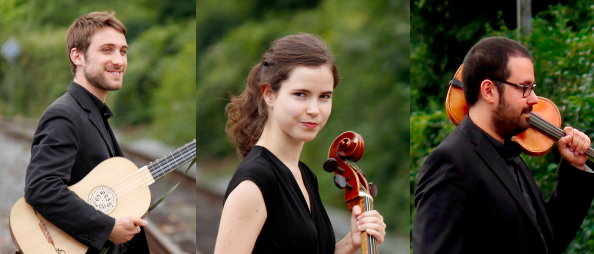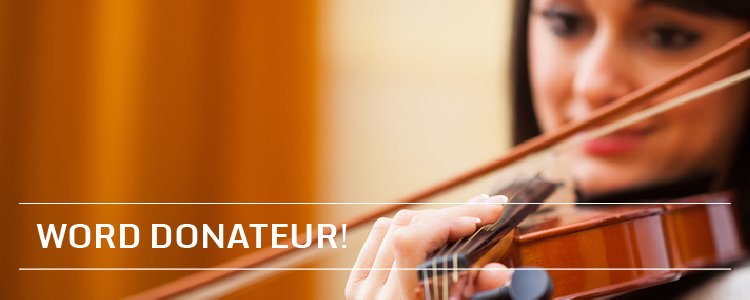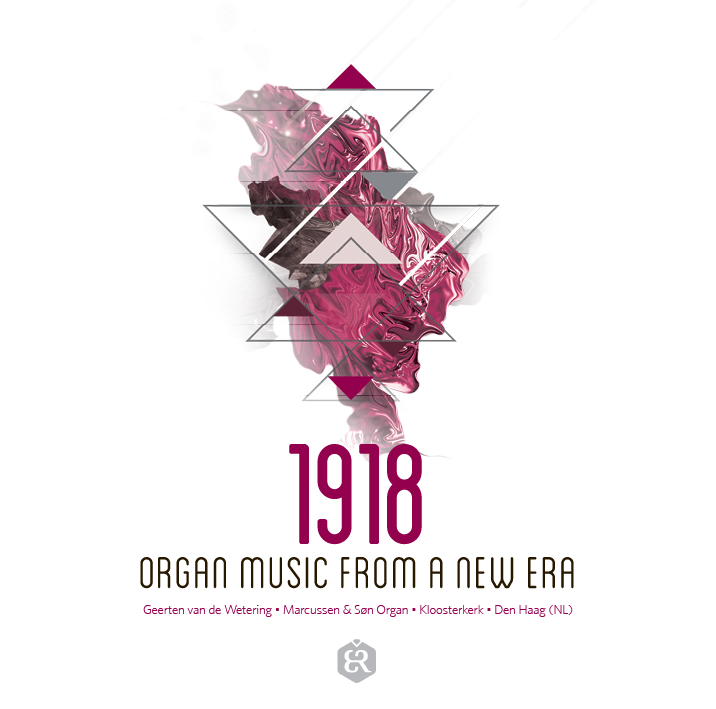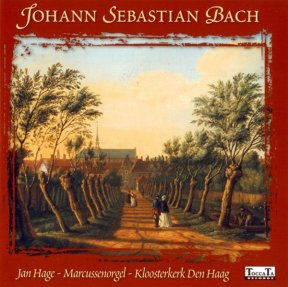Programma woensdag 15 april 2015
Scaramuccia: Javier Lupianez (viool), Ines Salinas (cello), Guilio Quirici (theorbe & barokgitaar)
- Aanvangstijd: 12:45 uur
- Locatie: Kloosterkerk
Programma New discoveries of Antonio Vivaldi
Antonio Vivaldi (1678-1741)
Violin Sonata in D major RV 10
- Allegro
- Allegro
- Adagio
- Allegro
Violin Sonata in A Major - New discovery (Lupiáñez, 2015)
- Adagio
- Allegro
- Largo
- Allegro
Violin Sonata in D Major RV 816 - Recent discovery (Talbot, 2011)
- Allegro
- Allegro
- Largo
- Allegro
Toelichting op het programma
Vivaldi is perhaps one of the most famous composers of all time, and yet we are still discovering his work. The present program features the most recent discovered Vivaldi sonatas for violin, and also the exciting presentation of one completely new work by the Venetian composer.
The year 2015 brings the discovery of a new work by Vivaldi the Sonata for violin in A major, identified by Lupiáñez in 2015 and to be included in the Vivaldian Catalogue (RV) at the end of 2015.
The piece is part of Pisendel’s collection in Dresden. Dresden is in fact one of the major archives of Vivaldi’s music. During the first part of 18th century the concertmaster of the Dresden court orchestra Georg Pisendel compiled a great amount of chamber music, especially music by Italian composers and Vivaldi. Pisendel was in fact a great friend of Vivaldi, and was one of his students.
One of the main reasons to attribute this works to Vivaldi is the significant amount of concordances and links with Vivaldi. Just to mention some of them, the first movement of the Sonata in A major is a re-utilization of the second movement of Vivaldi’s concerto RV 205. In addition we find more than fifty references in this sonata to other Vivaldian works and some formal structures that have been described as uniquely Vivaldian. This Vivaldian discovery will be added to the official Vivaldian Catalogue (RV) by the end of 2015.
The Sonata RV 10 is also found in Dresden. This is probably one of the most personal and original sonatas by Vivaldi and it is rarely performed with a historically informed approach. Perhaps not surprisingly it is performed more often by modern players in the arrangement of the piece for violin and piano made by Ottorino Respighi in 1910. Although it is a great arrangement, it takes the piece quite far from its original language. The Sonata RV 10 was conceived not to be published or to target a large list of customers, but for a closed circle of musicians and specially for his good friend and violin virtuoso Pisendel. The result is a very special piece, full of rhetoric, passion and imagination, masterminded by a great baroque musician (Vivaldi) to be placed in the hands of another great baroque musician (Pisendel).
The Sonata RV 816 is preserved uniquely in an English manuscript volume prepared for a keyboard player. The volume is now in the Gerald Coke Handel Foundation in London. The sonata was identified as a genuine Vivaldian work in 2011 by the eminent musicologist Mr. Michael Talbot. The sonata was written circa 1710 in a bright and fluent style although with some formal peculiarities: the Cadenza-like first movement is a unique case within the “solo” sonatas by Vivaldi.
Informatie over de uitvoerende(n)
Scaramuccia:  Javier Lupiáñez (viool), Inés Salinas (cello), Guilio Quirici (theorbe & barokgitaar), was founded in February 2013 on the initiative of violinist Javier Lupiáñez who aims to recover rarely played baroque repertoire.
Javier Lupiáñez (viool), Inés Salinas (cello), Guilio Quirici (theorbe & barokgitaar), was founded in February 2013 on the initiative of violinist Javier Lupiáñez who aims to recover rarely played baroque repertoire.
The spirit of Scaramuccia is to rediscover this cultural heritage, bringing to life music that was listened not only in more refined circles but also in the taverns and the streets in the baroque period. A deep research and study is done in the preparation of each program and concert in order to rediscover those little gems of music, hidden and lost amongst the vast and most commonly performed baroque music literature. Scaramuccia started in the Fringe of the Festival in Utrecht 2013 and in the Fringe in the Festival of Bruges 2013 and since then the ensemble is developing an intense concert schedule in the Netherlands, Belgium, UK and Portugal. Among other performances Scaramuccia has played in Maldon Festval of Arts (UK), the Muziekmuseum Vleeshuis (BE), the Kasteelconcerten (NL) series of concerts, and has also recorded for the Dutch Radio Concertzender.
In their zeal to discover new baroque repertoire Scaramuccia has performed the world premières of two new Vivaldi pieces in a live concert in the radio program De Musyck Kamer, broadcast in the Dutch Radio Concertzender in 2014.
Francisco Javier Lupiañez, violin. Javier was born in Melilla (Spain), where he receives several prizes in performing and composition. Violinist and musicologist. He had leaded several times ensembles such the Baroque Orchestra of the Superior Conservatory of Salamanca, Baroque Orchestra of Salamanca, the European Baroque Academy of Ambronay and Academia Montis Regalis. He develops also an intense work in chamber music playing with several ensembles all around the world. Javier is co-founder of the ensemble Les Esprits Animaux. He plays regularly in Spain, Portugal, France, Italy, Germany, Japan and The Netherlands. Javier has recorded for Harmonia Mundi, France Musique, Musiqu3 and Concertzender.
Now he is doing his Master Degree with Enrico Gatti at The Royal Conservatoire of The Hague discovering new pieces by Vivaldi. His results will be included in the Aggiornamento del catalogo Vivaldiano of 2015 and in the prestigious publication Studi Vivaldiani in its issue of 2015.
Javier has a baroque violin Verbeek made in 1682 on loan from the collection of The Dutch Musical Instruments Foundation. (http://www.muziekinstrumentenfonds.nl)
www.lupianbaroque.com
Inés Salinas, violoncello
Inés (Zaragoza, ES, 1985) is a musician specializedecialized in the historical performance of the cello and the viola da gamba. She holds a Bachelor Degree on classical cello from the CSMA (Zaragoza, ES), and on historical cello from the Koninklijk Conservatorium (Den Haag, NL). She is currently completing her Master’s Degree, under the the guidance of Jaap ter Linden on the historical cello, and Mieneke van der Velden on the viola da gamba. She has undertaken a master research about the cello in Naples at the turn of the 18th century.
Throughout her years of specialization in the historically informed performance, she has received tuition from Lucia Swarts, Gaetano Nasillo, Itziar Atutxa, Rainer Zipperling, Balázs Maté, Wieland Kuijken, Hidemi Suzuki, Christophe Coin, and Bruno Cocset.
She has performed with the Britten-Pears Baroque Orchestra (UK) in a project conducted by Christophe Rousset; with Orquesta Barroca Conde Duque (ES), conducted by Ángel Sampedro; and with I Giovani della Montis Regalis 2013 (IT), conducted by Olivia Centurioni, Alessandro de Marchi and Enrico Onofri. She is a founder member of the ensembles Scaramuccia and Duo Graziani.
inessalinas.webs.com
Giulio Quirici, baroque guitar. Giulio (b. 1987) studies early plucked instruments with Joachim Held and Mike Fentross at the Royal Conservatoire of The Hague.
He is continuo player in the chamber group Radio Antiqua, and performed in orchestras under the leadership of P. Pierlot, M. Fentross, S. Williams, E. Gatti and others. He also studied jazz guitar at the Conservatory of Music of Vicenza, in his native Italy, and alongside his formal studies he took courses given by world-class institutions such as the Berklee College of Music of Boston, the New School for Jazz and Contemporary Music of New York, the Hochschüle für die Kunsten Bremen, Mozarteum Salzburg, Festival Mitte Europa among others.


